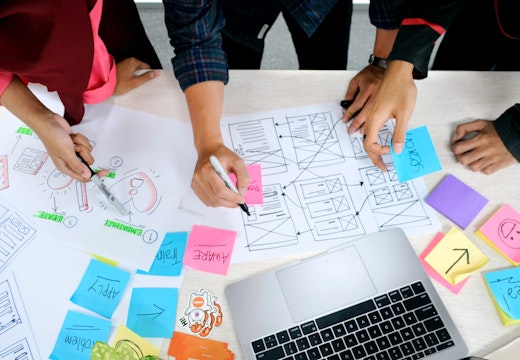Can design thinking bring clarity to the hybrid work experience?
The hybrid workplace will stand or fall on the quality of the technology experience. Canada’s ET Group is using the principles of design thinking to make user experience central to the development process
As hybrid work patterns take hold, business leaders are generally agreed that creating a great experience for everyone in the organisation is a priority, no matter where and how they are working. But there is far less consensus on how this might be organised or achieved.
Experience is all about how people encounter their workplace and what they feel about it. Do they feel supported and energised? Or are they disengaged and frustrated, and left feeling that they haven’t been given the right tools to do the job?
‘Technology is a significant factor in creating positive or negative experiences for employees…’
Technology is both an enabler of hybrid working and a significant factor in creating positive or negative experiences for employees. So, when it comes to technology integration for the hybrid workplace, shouldn’t businesses pay closer attention to the experiential dimension of their projects?
Canada’s ET Group, a leading collaboration technology integrator, believes they should. A focus on experience lies at the heart of making hybrid happen, which is why ET Group is pioneering the use of design thinking (DT) principles to gain key insights into user experience, test and learn, and improve how people feel about their work
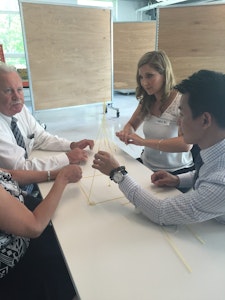
Image: ET Group
According to ET Group CEO Dirk Propfe, ‘People can describe their experiences better than they can describe the technology itself. An understanding of experience can help to align goals around what needs to be created on projects. It’s a good guiding light – it provides constraints and opens possibilities.’
Lisa Perrine, a strategic partner and advisor to ET Group on design thinking, adds: ‘It’s easier for people to say what’s been a negative experience, but we try to focus on the positive – we call this “appreciative inquiry”.’
Design for user experience
Design thinking first emerged in the aftermath of the global financial crash of 2008 as an alternative way to address business problems. It is a creative form of people-centred innovation with a particular focus on understanding and designing for the user experience. That’s why it resonates so strongly in the context of creating the hybrid workplace.
ET Group has been practising DT in collaboration with a range of international clients over the past two years. In the first article in this series, we studied the contours of ET Group’s approach and, in the second, we explored how its application of design thinking has enabled it to work more effectively with workspace designers. Our third article focused on the role of empathy within the DT process, and this fourth piece examines the dimension of human experience.
Awareness of experience
How aware are companies of the importance of experience as they contemplate the hybrid model? According to ET Group, there’s a growing trend among senior leaders to take the issue more seriously to create satisfying experiences for the workforce. New organisational job titles such as Chief Experience Officer (CXO) reflect this.
‘What’s exciting is that people are starting to talk about their experience of work and relationships, not just design and technology’, says Lisa Perrine. ‘There’s much more conversation than there ever was because people are rethinking how they want to work together.’
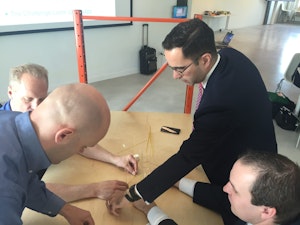
Image: ET Group
CEO Dirk Propfe adds that the managing partner of an ET Group client in financial services recently told him that he didn’t want any conversation around technology development that wasn’t explicitly about enhancing the user experience.
Methods for engagement
How does ET Group go about incorporating user experience into its projects? The answer lies in deploying the design thinking toolbox of methods to advance an agenda of human-centred design. Specifically, the ‘double diamond’ model in DT, which plots innovation across four stages (discover-define-develop-deliver), brings experiences to the fore.
The ‘problem diamond’ (discover-define) is where existing experiences are observed and analysed. The ‘solution diamond’ (develop-deliver) is where new and more ideal experiences are prototyped and tested. Lisa Perrine explains: ‘It’s an iterative process. People have got to have that dialogue about what is or isn’t working.’
‘Technology integration needs to do more to address digital equality…’
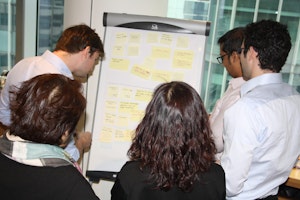
IMG_1492 Image: ET Group
Within this methodology, how does ET Group measure experience? Perrine says there are three main metrics – interaction, space and technology. She adds: ‘We’re also intrigued by emotion detection. We aren’t there yet – but measuring people’s energy in space, their facial expressions and the phrases they use. As long as it’s not intrusive, I think it will be a success in sensing the moment of an experience. I think people will be receptive to it in the future.’
Most negative experiences around hybrid work are centred on poor audio quality and the second-class experience that remote participants have in hybrid meetings. Technology integration needs to do more to address digital equality, says Dirk Propfe.
Learn and iterate
The extent to which design thinking techniques are woven upfront into ET Group projects depends on the scale and what is required. The DT framework is especially useful for projects with greater complexity and ambiguity at the ‘fuzzy front end’ of innovation. Lisa Perrine references Stewart Brand’s famous book, How Buildings Learn, in describing a process in which clients learn from early iterations and continue to make changes over time. Even when the project is technically ‘finished’, ET Group will check in with clients to support further adjustments.
Observations, photographs and self-narrated videos are used to analyse existing tech experiences. 2D, 3D and 4D full-sized mock-ups are built to explore new experiences, using the digital fly-through to show the possibilities. Michael Oppedisano, Project Lead at ET Group, explains that such methods are a good fit in terms of understand the needs of end users, educating them on what the technology can do, and providing a bridge to co-creation activities.
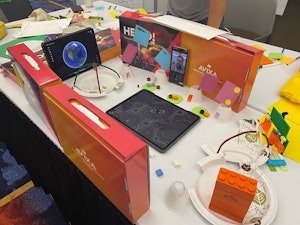
Image: ET Group
‘It’s important to be iterative and co-creating with clients,’ says Lisa Perrine. ‘There’s nothing like mocking up the space and have people come in and experience it. We create early rough protypes and continue to refine them. It helps to create a new level of community around the project.’
‘The future could see more personalised experiences and multiple layers of interaction…’
Clearly, design thinking can get to the heart of an experience rather than just providing an externalised solution. But we are still on the foothills of what might be possible in the future. The ET team envisages designing for more personalised experiences and multiple layers of interaction as part of a matrix approach to the technology experience.
As companies try to figure out hybrid working at the level of each individual’s experience, that prospect could be very appealing.


